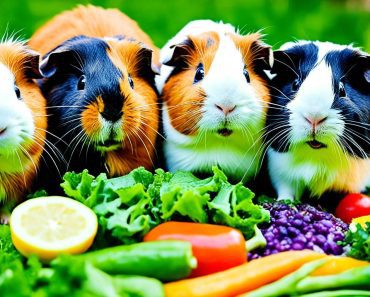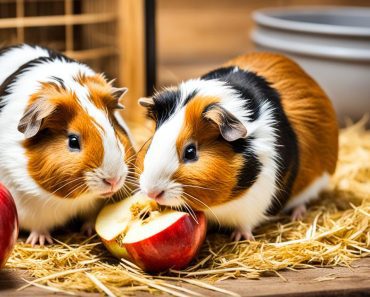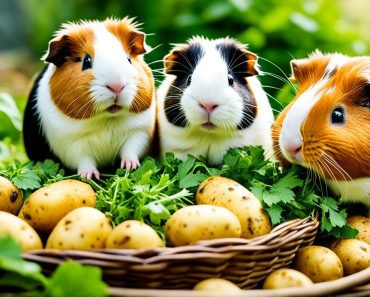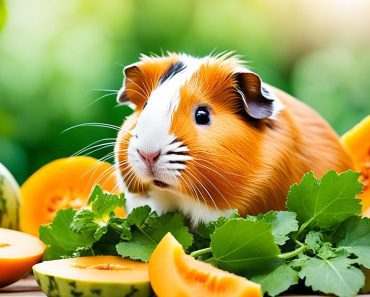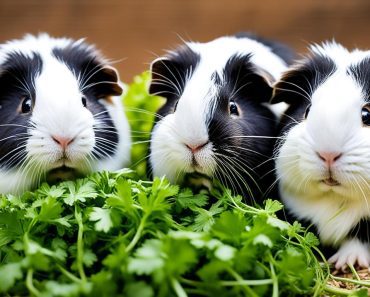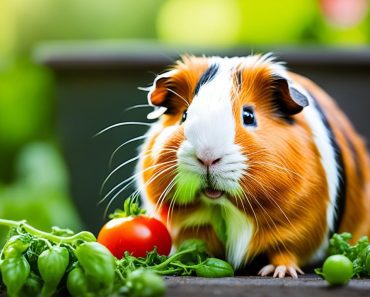Hello, fellow guinea pig enthusiasts! Today, I’m excited to delve into the topic of guinea pig diets and answer a burning question that many owners have: can guinea pigs eat red peppers? As a dedicated guinea pig lover myself, I’ve conducted extensive research to provide you with accurate and reliable information. So, let’s dive right in!
When it comes to the guinea pig diet, it’s essential to provide them with safe and nutritious foods that promote their overall health and well-being. Guinea pigs are herbivores, so a diet rich in vegetables is vital to meet their nutritional requirements. But can red peppers be a part of their diet? Let’s find out!
After careful analysis, I can confidently say that guinea pigs can indeed eat red peppers. In fact, all colors of bell peppers are safe and healthy for them. Red peppers, in particular, are an excellent addition to their diet due to their high vitamin C content. Vitamin C is crucial for guinea pigs as it helps prevent scurvy and boosts their immune system.
However, it’s important to note that different colors of bell peppers contain varying amounts of vitamin C and calcium. While all colors can be safely consumed in moderation, green bell peppers have lower sugar content and are the best option for guinea pigs. Nonetheless, you can still offer red peppers as a treat on occasion.
As with any food, it’s essential to practice moderation. Too many red peppers can lead to obesity and diabetes in guinea pigs due to their high sugar content. Additionally, the seeds of bell peppers can pose a choking hazard, so remember to remove them before feeding red peppers to your furry friends.
So, red peppers can be a delicious and healthy addition to your guinea pig’s diet. With the right portioning and proper care, you can enhance their overall health and ensure they receive the necessary vitamins and minerals they need to thrive. Now that we’ve uncovered the truth about guinea pigs and red peppers, let’s take a look at some key takeaways:
Can Guinea Pigs Eat Red Peppers? Yes, they can be safely consumed.
- Guinea pigs can safely eat red peppers, along with other colors of bell peppers.
- Bell peppers are rich in vitamin C, which is essential for guinea pigs to prevent scurvy.
- Green bell peppers have lower sugar content and are the best option for guinea pigs.
- Remove the seeds before feeding bell peppers to guinea pigs to avoid choking hazards.
- Moderation is key to prevent obesity and diabetes in guinea pigs.
The Importance of Fresh Vegetables in a Guinea Pig’s Diet
Fresh vegetables are a key element in maintaining a healthy diet for guinea pigs. They provide essential vitamins, minerals, and fiber that contribute to overall well-being and promote optimal nutrition. Incorporating a variety of fresh vegetables into your guinea pig’s diet ensures they receive a wide range of nutrients to support their health.
Leafy greens are particularly beneficial for guinea pigs and should be included daily in their diet. Examples of leafy greens include romaine lettuce, kale, spinach, and swiss chard. These greens are rich sources of vitamins and minerals, including calcium and iron, which are important for your guinea pig’s bone health and overall vitality.
Guinea pigs should have a daily serving of leafy greens, approximately one cup per day. This ensures they receive an adequate amount of essential nutrients to support their well-being and provide the necessary fiber for proper digestion.
Another vegetable that is excellent for guinea pigs is bell peppers, especially yellow ones. Bell peppers are rich in vitamin C, a vital nutrient for guinea pigs. Vitamin C is essential for their overall health, as it helps prevent scurvy and boosts their immune system. Including bell peppers in your guinea pig’s diet ensures they receive a natural source of vitamin C to support their well-being.
Here is a list of other safe vegetables that you can incorporate into your guinea pig’s diet:
- Carrots
- Cucumbers
- Zucchini
- Peas
- Beans
When introducing new vegetables to your guinea pig, it’s important to do so gradually and monitor their response. Each guinea pig may have individual preferences and tolerances to certain vegetables. By introducing new vegetables slowly, you can ensure that your guinea pig tolerates them well and avoid any potential digestive upsets.
Remember, vegetables should be served after your guinea pig has eaten their daily hay and pellets. Hay should be the foundation of their diet, as it provides essential fiber for proper digestion. Including a variety of fresh vegetables complements their nutritional needs and ensures they receive a well-rounded diet.
Now, let’s take a look at the nutritional composition of different vegetables commonly included in a guinea pig’s diet:
| Vegetable | Vitamin C (mg/100g) | Calcium (mg/100g) |
|---|---|---|
| Romaine Lettuce | 2.4 | 35 |
| Kale | 120 | 150 |
| Spinach | 28 | 99 |
| Swiss Chard | 30 | 58 |
| Bell Peppers (yellow) | 183 | 9 |
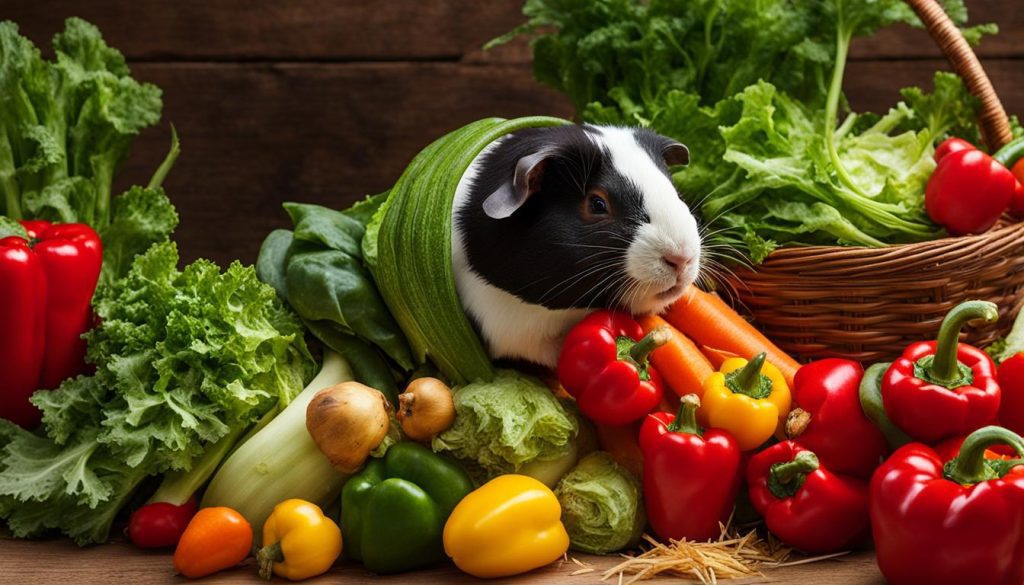
As you can see, incorporating a variety of fresh vegetables into your guinea pig’s diet provides them with essential nutrition while also adding variety to their meals. Remember to serve vegetables in moderation, as overfeeding can lead to digestive issues and obesity. By offering a balanced diet of hay, pellets, and fresh vegetables, you can ensure your guinea pig receives the necessary nutrients for a healthy and happy life.
The Role of Hay in a Guinea Pig’s Diet
Hay plays a crucial role in a guinea pig’s diet, providing essential nutrients and promoting their overall well-being. It is important to understand the significance of hay in maintaining the dental and digestive health of these adorable pets.
The Importance of Hay
Guinea pigs are herbivores, and their diets should primarily consist of hay. This grass-based food is rich in fiber, which aids in proper digestion and prevents gastrointestinal issues.
Hay also serves as a natural toothbrush for guinea pigs. Their constantly growing teeth require regular wear to prevent overgrowth and dental problems. Chewing on hay helps wear down their teeth, keeping them at an appropriate length and preventing painful dental issues.
Types of Grass Hay
Guinea pigs should have access to a variety of grass hays to ensure a balanced diet. Here are some popular options:
| Grass Hay Type | Description |
|---|---|
| Timothy Hay | A common and widely available hay with a good balance of nutrients. It promotes healthy digestion and dental wear. |
| Oat Hay | Rich in fiber and low in calcium, making it an excellent option for adult guinea pigs. |
| Orchard Grass | Similar to Timothy hay, it provides essential nutrients and aids in digestive health. |
| Alfalfa Hay | Best suited for young, pregnant, nursing, or ill guinea pigs due to its higher nutritional elements. It should be given sparingly to adult guinea pigs. |
It is crucial to ensure that the hay provided is fresh and free from mold or dust. Remember to store it in a cool, dry place to maintain its quality.
Feeding Recommendations
The amount of hay a guinea pig requires depends on their weight. A general guideline is to offer a pile of hay twice the size of their body daily. This ensures they have sufficient hay to chew on throughout the day.
Avoid feeding guinea pigs grass from the lawn as it may contain harmful chemicals and can ferment too rapidly, leading to digestive issues.
Hay should be the foundation of a guinea pig’s diet, making up the majority of their food intake. Alongside hay, provide a variety of fresh vegetables to complement their nutritional needs. Pelleted food can also be offered in moderation, ensuring it is specifically formulated for guinea pigs.
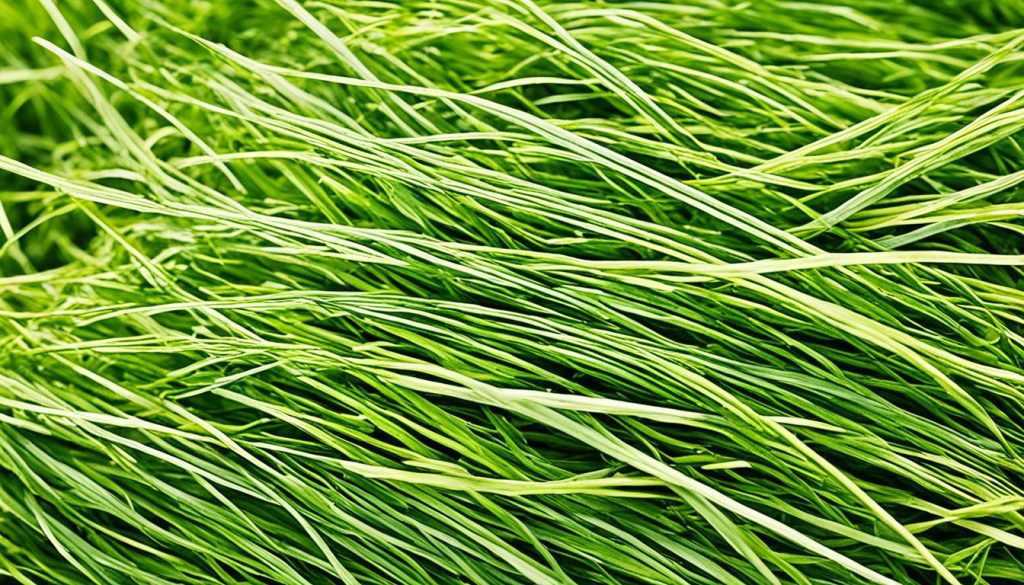
The Importance of a Balanced Diet for Guinea Pigs
A balanced diet is crucial for the overall health and well-being of guinea pigs. In addition to hay and fresh vegetables, guinea pigs should be provided with a fortified pelleted food that contains essential vitamins and minerals. This ensures that they receive all the nutrients they need for optimal health and growth.
One of the key nutrients that guinea pigs require is vitamin C. Unlike humans, guinea pigs cannot produce vitamin C on their own, so it is important to provide them with a dietary source. Lack of vitamin C can lead to scurvy, a condition that can cause weakness, joint pain, and even death in guinea pigs. Hence, daily supplementation of vitamin C or feeding foods high in vitamin C is necessary to meet their dietary requirements.
Treats are an enjoyable part of a guinea pig’s diet, but it’s important to offer them in moderation. Treats should be specifically designed for guinea pigs and provide additional nutritional benefits. Avoid giving them foods that are harmful to their health, such as avocados, grapes, and onions.
“A balanced diet is essential for guinea pigs to ensure they receive the necessary nutrients for their overall health and well-being.” – Dr. Emily Garcia, DVM
It is crucial to follow the manufacturer’s recommendations when it comes to feeding pelleted food. Each brand may have different guidelines regarding the appropriate amount to feed your guinea pig. The pelleted food must be chosen based on the age and specific needs of your guinea pig.
Cleaning up any uneaten fresh foods is also important to prevent mold or rot. Guinea pigs can be sensitive to spoiled food, which can lead to digestive issues and other health problems.
Vitamins and Minerals for Guinea Pigs
| Nutrient | Functions | Sources |
|---|---|---|
| Vitamin C | Aids in collagen production, boosts immune system | Fortified guinea pig pellets, fresh vegetables (e.g., bell peppers) |
| Vitamin A | Promotes healthy vision and growth | Carrots, dark leafy greens (e.g., kale, spinach) |
| Vitamin D | Aids in calcium absorption and bone health | Sunlight exposure, fortified foods |
| Calcium | Supports bone and teeth health | Timothy hay, leafy greens, fortified foods |
| Phosphorus | Contributes to bone and teeth health, energy metabolism | Fortified foods, leafy greens |
Providing a balanced diet that includes a variety of vegetables, along with fortified pellets and hay, ensures that guinea pigs receive all the necessary vitamins and minerals for optimal health. It’s important to consult with a veterinarian to determine the specific dietary requirements of your guinea pig based on its age, activity level, and overall health condition.
Conclusion
After conducting thorough research on guinea pig diet and nutrition, it is clear that red peppers can be safely incorporated into their balanced diet. Alongside other vegetables and hay, red peppers provide the necessary nutrients for guinea pigs to thrive and maintain optimal health.
However, it is crucial to consider the specific nutritional needs of guinea pigs and introduce new foods in moderation. Monitoring their response and ensuring their tolerance is essential for their well-being.
By following proper dietary guidelines, such as providing a variety of foods and ensuring a well-rounded diet, guinea pig owners can ensure the overall well-being and longevity of their furry friends. Maintaining a balanced guinea pig diet, which includes red peppers as a part of optimal nutrition, will contribute to their overall health and happiness.

